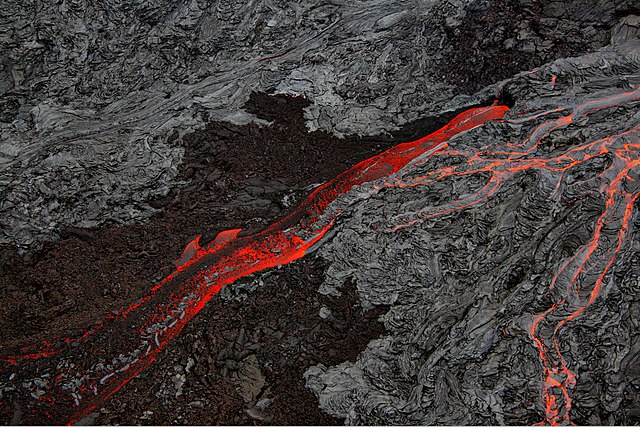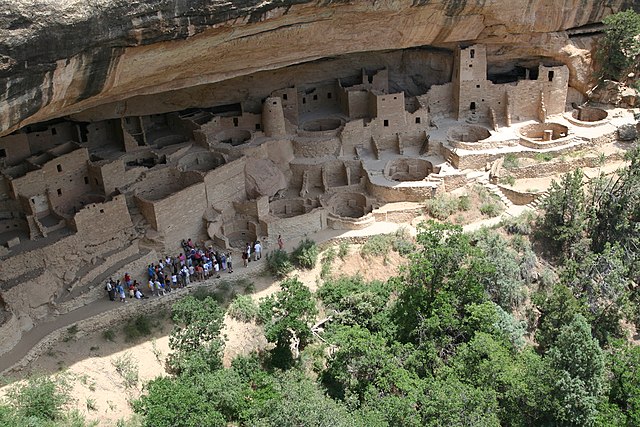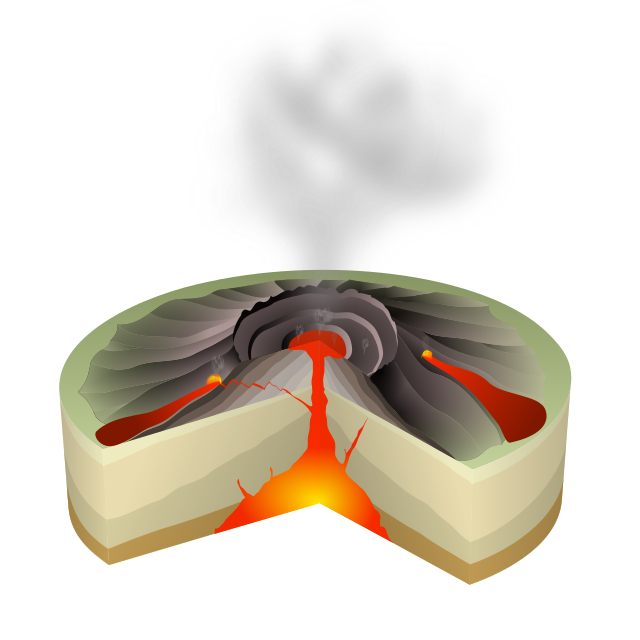Hawaiʻi Volcanoes National Park
Hawaiʻi Volcanoes National Park is an American national park located in the U.S. state of Hawaii on the island of Hawaii. The park encompasses two active volcanoes: Kīlauea, one of the world's most active volcanoes, and Mauna Loa, the world's most massive shield volcano. The park provides scientists with insight into the development of the Hawaiian Islands and access for studies of volcanism. For visitors, the park offers dramatic volcanic landscapes, glimpses of rare flora and fauna, and a view into the traditional Hawaiian culture connected to these landscapes.
The park was originally established on August 1, 1916 as Hawaii National Park, which was then split into this park and Haleakalā National Park. In recognition of its outstanding natural values, Hawaiʻi Volcanoes National Park was designated as an International Biosphere Reserve in 1980 and a World Heritage Site in 1987. In 2012, the park was depicted on the 14th quarter of the America the Beautiful Quarters series.
On May 11, 2018, the park was closed to the public in the Kīlauea volcano summit area, including the visitor center and park headquarters, due to explosions and toxic ash clouds from Halemaʻumaʻu, as well as earthquakes and road damage. Portions of the park, including the visitor center, reopened to the public on September 22, 2018. As of 2020, most of the park is open; however, some road segments and trails as well as the Jaggar Museum of the Hawaiian Volcano Observatory remain closed to visitors.Eruptive activity, ground collapses and explosions in the park ceased in early August of 2018, and the lull in eruptive activity at Kīlauea continued until an eruption on December 20, 2020, at the Halemaʻumaʻu crater.
Links
Images Gallery
-

-

-
 Lava erupting from the Puʻu ʻŌʻō vent in June 1983
Lava erupting from the Puʻu ʻŌʻō vent in June 1983
-
-

-
 Sulfur dioxide emissions from the Halemaʻumaʻu vent, April 2008
Sulfur dioxide emissions from the Halemaʻumaʻu vent, April 2008
-

-

-
 Aerial view of Halemaʻumaʻu, September 2009
Aerial view of Halemaʻumaʻu, September 2009
-
 The Volcano Art Center was the Volcano House Hotel from 1877 to 1921.
The Volcano Art Center was the Volcano House Hotel from 1877 to 1921.
-
 Thurston lava tube in Hawaiʻi Volcanoes National Park
Thurston lava tube in Hawaiʻi Volcanoes National Park
-
 Park map including the Kahuku District on left (click to enlarge)
Park map including the Kahuku District on left (click to enlarge)
-
 Wilkes Campsite on Mauna Loa
Wilkes Campsite on Mauna Loa
-
 Night view of Halemaʻumaʻu from Jaggar Museum in 2015
Night view of Halemaʻumaʻu from Jaggar Museum in 2015
-
 D. Howard Hitchcock painting of Pele
D. Howard Hitchcock painting of Pele
-

-

-

-

-

-

-

-

-

-

-

-

-

-

-

-

-

-

-

-

-

-

-

-

-

-
-

-

-

-

-

-

-

-

-

-

-

-

-

-

-

-

-

-

-

-

-

-

-

-

-

-

-

-
-

-

-

-

-

-

-

-

-

-

-

-

-

-

-
-

-

Comments
-
This National Park is an absolute must visit for every trip to the Big Island. It is amazing to see the different landscapes that have been created by the volcanoes, whether you hike or only drive. It was incredible to see how nature finds a way to survive and even thrive in the lava flows. The chain of craters drive from the rim down to the coast is fantastic and offers so much to see and learn about the different lava flows and eruptions. We listened to the gypsy app while driving and it was very educational.
a week ago -
Great experience. You drive through in your car to the different sites. The price to visit is on the higher end but worth it. It is amazing to see the volcano. The site where you see the vapor rise from the fires beneath is very amazing to see and feel. There are many trails were you can walk and see nature. Wonderful day trip if you are vacationing on Hawai’i. We had a great time.
a week ago -
The walk to Thurston is short and easy, but be sure to arrive early! Parking is minimal, but the walk through the tunnel is very short. So if you hang a bit in your car, you’ll find people coming back quickly, opening up parking. The timeless is lit and damp, take actual shoes. Flip flops would be a bit sketch. We actually looped back around and walked the tunnel a 2nd time. But def worth checking out!!
6 days ago -
Magnificent! My husband and I spent 2 days here: On Day 1 we hiked the Crater Rim Trail, went to the lava tube, and walked in the old crater. On Day 2 we tried to see sunrise at the highest lookout but didn’t make it due to cloudy weather. But later we did the Steam Vents Trail and Sulfur Bank which were interesting and educational. The gallery near Visitor Center is also pretty nice.
2 days ago -
Kilauea Iki hike was not too bad. Well maintained trail. Did it with my 1 yr old in an Ergo carrier. Cool view of the crater from the road up top and from within. Better than the view of the main Kilauea crater (no volcanic activity when I went in Aug 2021).
a week ago -
I highly recommend visiting this national park! I loved walking down to the crater and through the lava tube. I think this is a family friendly moderate hike. I would suggest packing water in a reusable container, wearing hiking shoes and layers. There are uneven stairs to ascend/descend as well as uneven terrain. The hike to/from the crater took approximately 2 hrs with stops for pics whereas the lava tube took 15 minutes. Parking is busy so get there early! Oh and remember to LEAVE NO TRACE, TAKE ONLY PICTURES. ❤️ Mahalo ❤️
6 days ago -
It's like visiting another world. Set aside 3 or more hours for chain of craters road so you can do multiple stops and side trails. There are easy trails and harder ones. Hiking down to the caldera is unforgettable, but the end of chain of craters is not to be missed.
3 weeks ago -
We had an awesome day at the park, even though it rained on and off all day. The best was hiking down into the crater (I forget what the hike was called) but it was as if we were on another planet.
2 weeks ago





















































































